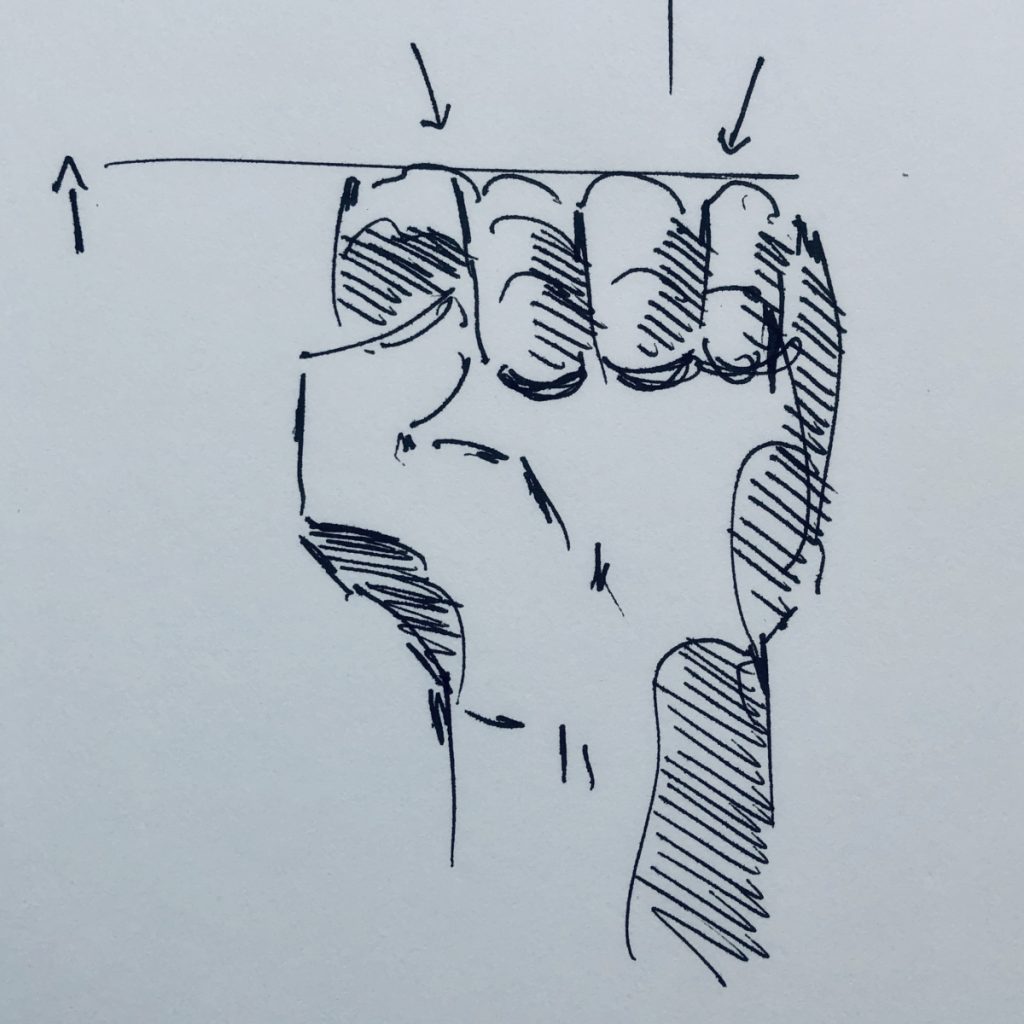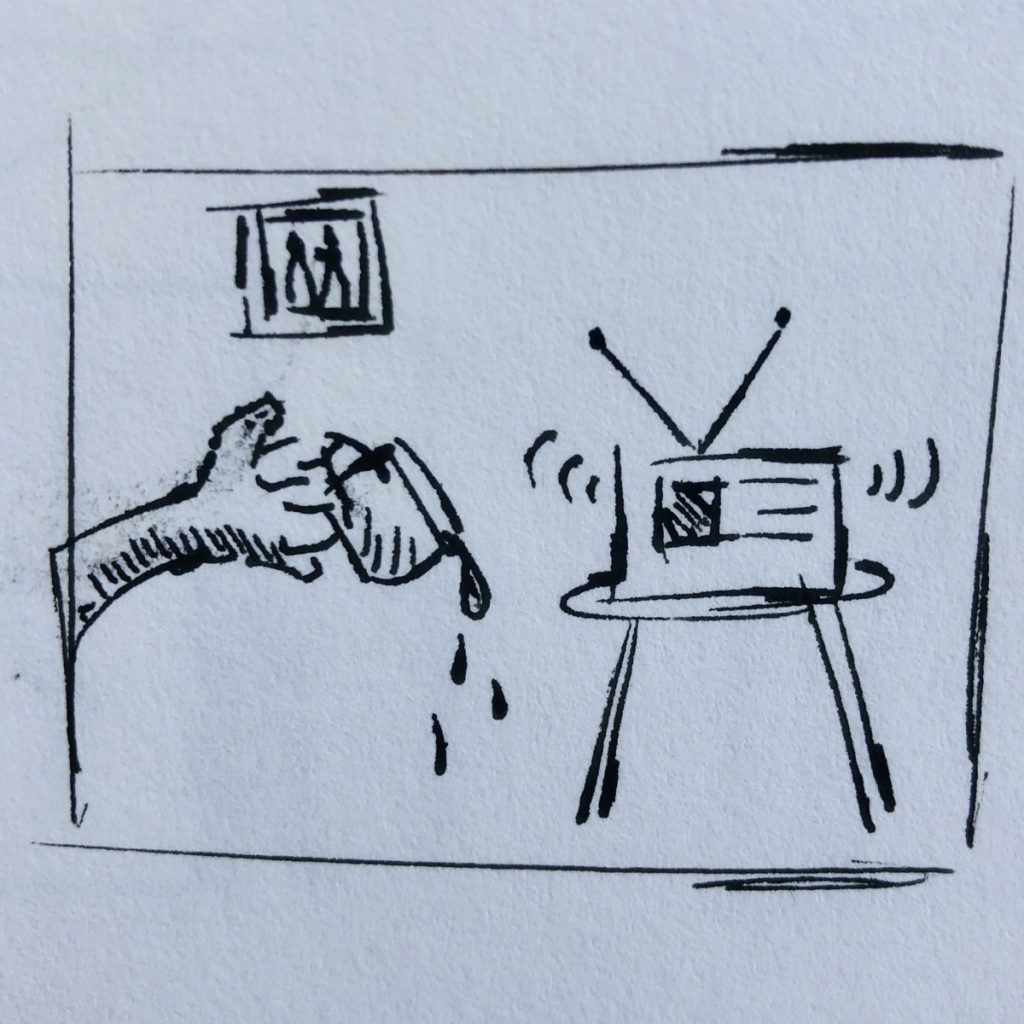The last piece of research identified two potential directions for my FMP outcome. After sharing those ideas and receiving feedback, I decided to carry out two separate experiments to take each forward and determine which would create a more fruitful outcome:
- A large arm and hand sculpture – a potential outcome that would be on public view and be encrusted with relevant artefacts
- A cartoon adventure strip – taking the hand as the main feature and using absurdity and humour to create a reaction to trauma
Experiment #1: Hand sculpture
Available materials were limited but I did have wire mesh and garden moss so these were used to create a large arm and hand. The moss was used merely to judge the developing shape but it was actually quite a pleasing result. The idea of filling the arm with a material that could in theory be gathered from Cranswick has an interesting resonance.
The result was quite striking and seeing a large version does create an imposing feeling of clamouring for air or life. I purposely made the arm quite delicate compared to the hand to try to indicate this was the arm of a child. So we have delicacy but also a powerful force emerging from the earth. Another thought was that a hand rising up gives the impression of the revisiting of buried memories.
I do feel that this sculpture has potential – multiples of the same arm would add even more potency. We also need to consider whether adding the bomb (or a representation of it) is still necessary. We did talk of the hand catching the bomb and multiples could show various representations of this action. We also need to consider encrusting the sculpture with the pages of an historic adventure story as discussed previously. We decided to park this experiment for the time being to allow more ideas to generate while we worked on the next piece.
Experiment #2: Cartoon adventure strip
As the hand was to be a critical part of any drawings, a refresher in the basics of hand drawing was thought useful. Proko was used as inspiration. While not aiming for realism, rather a personal sketched style, it was thought useful to ensure the basic anatomy was believable.
It was then useful to photograph a variety of my own hand positions to use as reference for the drawings. Restricting these to black and white ensured we could focus on basic forms and tones.
A set of sample drawings were then quickly created using off the cuff ideas of how to create a mix of humour, social scenes and more shocking indications of a traumatic event. It was clear that we had no shortage of material and comic reference – the idea of a severed arm could be used to construct surreal and comic scenes, without the need for captions. If these scenes were in pairs a dynamic dialogue could also be created where we give the viewer permission to fill in the gaps in the story – the classic pull of the graphic novel.
It was very enjoyable creating these drawings and I felt I was adding a social context to the war experience. Wrapping these imagined scenes around a rather blurred story adds a layer of fantasy, of a dream. The arm pierces this with a level of absurdity that I enjoy as it creates a continuous thread of a type that a child might create. In addition, humour is proving to be quite potent as it is cited as one of the most effective ways to deal with trauma. These drawings were created very quickly so I am intrigued to think what could be produced with more finesse.
I then thought about how to create a set of drawings like those above but add a contextual reference. The previous milk drawings had proved very successful so I created a set of small 8 cm square water colour papers. This size was chosen to mimic the size of early photographs from the 1940s which were of a similar size – the classic family portrait size. I then created a 1 cm paper frame and painted milk on the inside of this on each of the papers and baked them in the oven. The result was a unique burnt pattern on each square that I though may give a suitable background for the drawing but it also adds a white border, again mimicking a photograph.
A sample drawing on one of the squares had potential however I felt that the fine liner was too small – 3 mm was used but the line quality was thin. A larger size will be tried to loosen up my style as for the test drawings.
A further drawing experiment below added a black square border around the drawing. I believe this is more pleasing as it frames the drawing but allows the milk and drawing to spill out of the frame. This adds to the photography aesthetic by adding a clean definition between border and photograph.

Creating an installation of the drawings was the next consideration. I happen to own an old parish council notice board (that has never had any use) that could be re-purposed to display the drawings. A grid of 4 x 4 drawings could be placed inside and raised from the rear. We then have the potential of placing newspaper or pages from an adventure book in the background. Lighting could also be added around the edges. Obviously the name at the top would be changed to be ‘CRANSWICK’. Is this adding the final link in the jigsaw? We have added an official stamp to the outcome but also another layer of absurdity – which I enjoy. This arrangement could now be site specific if we placed it at the location of the event in 1941. The intrigue of watching the public view and discuss the scenes would be fascinating. We could also include a mechanism for people to submit their own stories and have them drawn in further ‘episodes’ of the story. I am naturally drawn to art that has the potential to evolve over time so this is very appealing so we will create more drawings and experiment further with the presentation.

Research on the science of humour
In parallel with creating the drawings, research involved looking at the work of Simon Critchley who has investigated the philosophy of humour. This was felt important to understand how and why humour works and how to employ it in an artistic situation:
A summary of the most relevant points is below:
- Humour shows how a society operates – it gets under the hood of a regime
- A joke has a social contract between the teller and the audience – the audience must accept they will be told a joke and react
- Jokes work through incongruity – that is what we expect to take place and what does take place
- A joke only works if the receiver understands the rules and follows the them – joking is like throwing the ball, the joker throws a ball and the receiver must throw it back, however in certain cultures the joke is thrown on the receiver puts it in their pocket
- A joke is a ‘rite’ in that it plays with the symbolic forms of society – a joke often mocks the rights of a given society
- Jokes allows us to look at the world in a very abstract way
The notion of incongruity jumps out above, as even in my early drawings, the absurdity I drew is moving in this direction. More interesting however is how humour mocks the rites of society and this is worthy of deeper exploration. One can imagine the world in 1940s England being quite regimented, traditional and male emotion in particular being quite lacking. Giving this a reference in drawn form may add another layer to the outcome – do we show how the ‘stiff upper lip’ in the 1940s impacted the nature of trauma experienced?










































